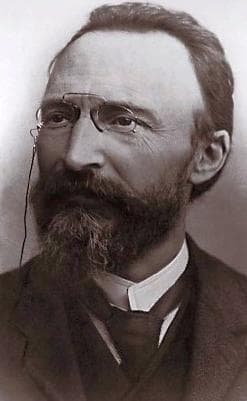
Blessed Bartholomew Longo
Blessed
Feast Day: October 5
Birth: February 11, 1841
Death: October 5, 1926
Biography
Blessed Bartholomew Longo, also known as Bartolo Longo, Bartolomea Longo, and Bartolomeo Longo di Latiano, was born on February 11, 1841, in the small town of Latiano, located in southern Italy. Born into a pious family, he was the son of a physician and had the privilege of receiving a good education, both secular and Christian. In fact, his family would gather every night to pray the Rosary together, instilling in young Bartholomew a deep devotion to the Blessed Virgin Mary.
As a young man, Bartholomew attended a Piarist school until the age of sixteen. He proved to be an excellent student and displayed talents in literature, oratory, fencing, dancing, music, and various other arts. He was known to be restless and had difficulty sitting through classes, but nevertheless, his academic abilities remained exceptional. In addition to this, Bartholomew also possessed musical skills and could play both the flute and piano. He even directed a school band during his time at the Piarist school.
After completing his studies at the Piarist school, Bartholomew pursued law at the University of Naples. He successfully obtained his degree in 1864, but unfortunately, he fell into a dissolute and worldly lifestyle during his time at the university. This dramatic shift in his behavior was influenced by a philosophy class taught by a fallen-away priest. From indifference to the Church, Bartholomew progressed to ridicule and eventually open hostility towards the Catholic faith.
It was during this period of his life that Bartholomew became involved in street demonstrations against the Pope and dabbled in occult practices such as magnetism and spiritism. He indulged in activities that involved tipping tables and attempting to contact the spirit world through mediums. Eventually, he burned his bridges and embraced Satanism, going as far as becoming a satanic priest after further study and involvement in the occult.
Despite Bartholomew's descent into the darkness of Satanism, his family and friends never gave up hope for his conversion. They fervently prayed for his return to the faith and persistently addressed his interest in the occult. One of the key figures in Bartholomew's journey back to the Catholic Church was Vincente Pepe, a respected professor from his hometown. Pepe played a crucial role in persuading Bartholomew to turn away from the occult.
Additionally, a Dominican friar by the name of Father Albert guided Bartholomew through a process akin to deprogramming, helping him recover his senses and rediscover his faith. Motivated by his desire to make amends for his apostasy, Bartholomew, now known as Brother Rosary or Fratel Rosario, began preaching against the occult in locations frequented by college students.
Father Albert supported Bartholomew's desire to help the poor, and together with a group of local laypeople, he joined efforts to assist those in need. Witnessing the extreme poverty endured by many, Bartholomew had a sudden inspiration that the Rosary could become a powerful means of providing aid. He established a shrine dedicated to Our Lady of the Rosary in the valley of Pompei, utilizing a discarded painting of Mary as a visual representation.
The shrine quickly attracted pilgrims, miracles were reported, and the crowds grew larger with each passing day. Recognizing the significance of Bartholomew's work, the local bishop requested him to construct a new church. Construction began in 1876, the church was dedicated in 1887, and on February 19, 1894, it was given to the papacy. In 1901, Pope Leo XIII designated it as a basilica. Today, the Rosary Basilica in Pompei receives approximately 10,000 pilgrims daily.
Bartholomew, alongside Mariana, the widowed Countess di Fusco, established other charitable institutions in the vicinity, which eventually formed what was known as the City of Charity or City of Mary. To provide proper care for the orphaned children within the City, Bartholomew founded the Daughters of the Rosary of Pompeii.
Furthermore, he established a trade school called the Sons of the Imprisoned for boys whose fathers were incarcerated. This school was placed under the direction of the Brothers of Christian Schools. Contrary to the contemporary assumption that children with criminal parents were destined to follow the same path, the success of this trade school disproved this belief. In 1922, Bartholomew established a sister school for the daughters of prisoners, further emphasizing his dedication to helping those most in need.
Bartholomew faced various challenges throughout his life, including rumors and gossip surrounding his relationship with Mariana di Fusco. To avoid any negative implications on their charitable work, the two decided to marry in April 1885. However, they lived together chastely, adhering to private vows they had made. Despite their efforts to dispel the rumors, accusations of adultery, profiteering, dishonesty, and even insanity were still directed at Bartholomew in the early years of the 20th century.
In 1906, Pope Saint Pius X asked Bartholomew to retire as the administrator of the City, as an attempt to preserve its integrity. Adhering to this request, Bartholomew surrendered control of the City to the papacy and took on a regular job as an employee within the City. In recognition of his devotion and service, Bartholomew was made a Knight of the Guard Cross of the Holy Sepulcher in 1925.
Blessed Bartholomew Longo passed away on October 5, 1926, due to pneumonia. He was buried in the crypt of the Rosary Basilica alongside his wife, Mariana. Bartholomew's virtues and holiness were formally recognized on October 3, 1975, when Pope Paul VI declared him venerable. Later, on October 26, 1980, Pope John Paul II beatified Bartholomew Longo, acknowledging his inspiring journey of conversion, his dedication to the Rosary, and his substantial contributions to charitable work.